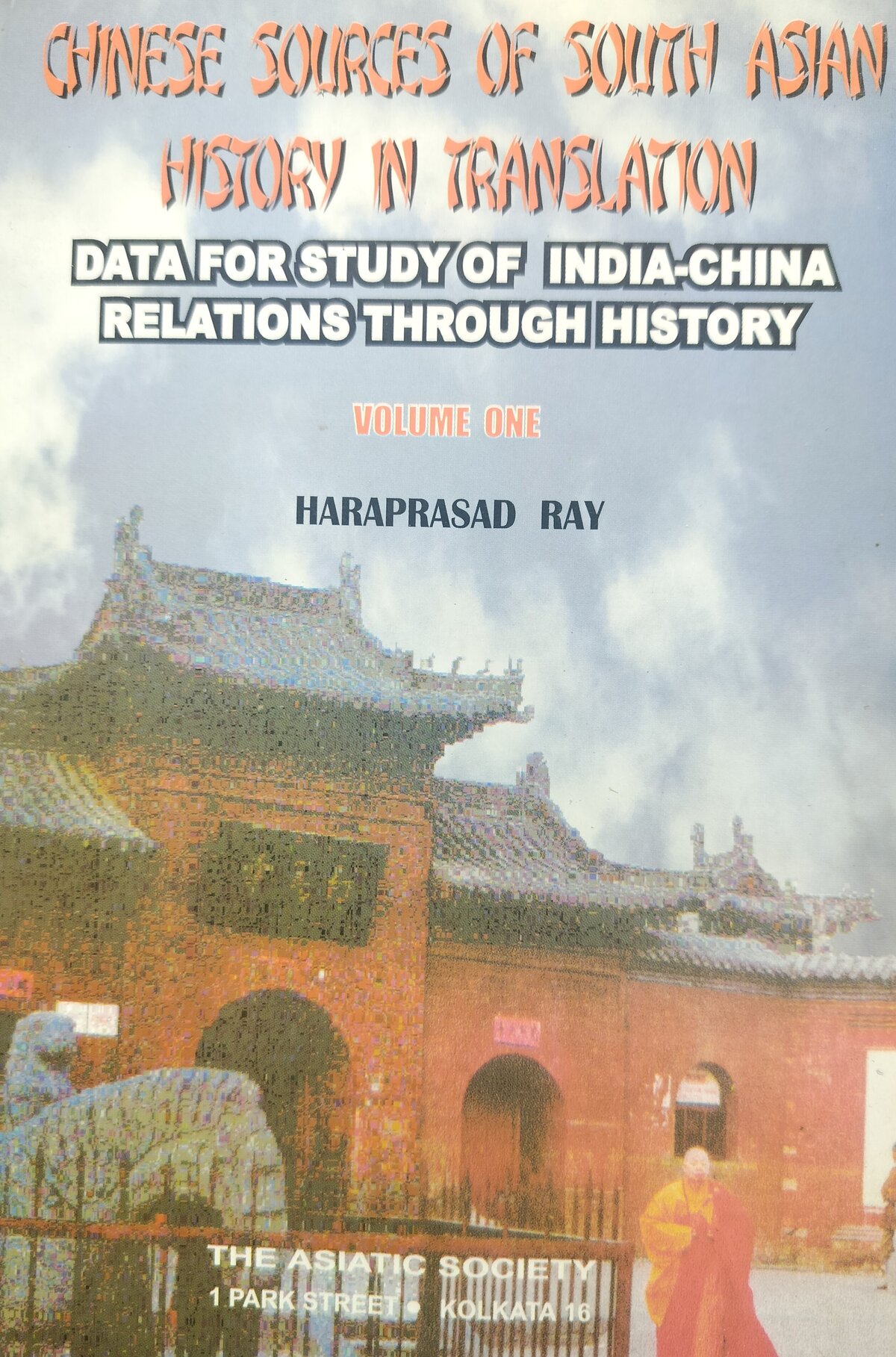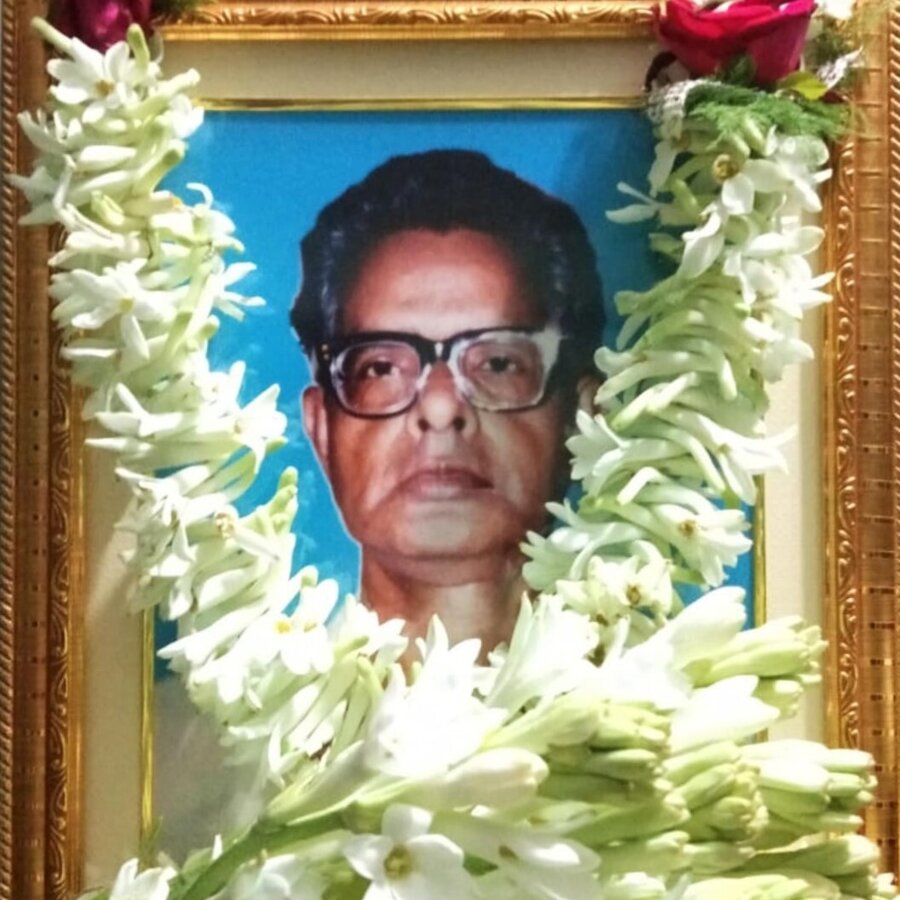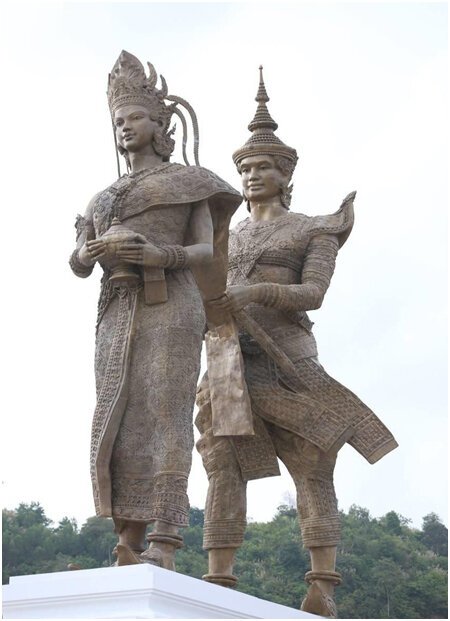Chinese Sources of South Asian History in Translation, Vol 1
by Haraprasad Ray
First volume of the monumental work led by Indian scholar Haraprasad Ray, collecting "Data for the study of India-China relations through history."

Type: hardback
Publisher: The Asiatic Society, Kolkata
Published: 2004
Author: Haraprasad Ray
Pages: 224
ISBN: 81 7236 151 3
Language : English
ADB Library Catalog ID: INDCHIRAY1
Spanning from the 3d century BCE to the 6th century CE, this exhaustive study deals with Chinese written sources produced during the Qin Dynasty, the former and later Han Dynasties, the Period of the Three Kingdoms, and the (Liu) Song, Southern Qi, Northern, Eastern and Western Wei Dynasties.
At that time, Chinese military men, travelers, geographers and chroniclers were mostly turning their attention to the Western regions, and in particular to Indian Northwest and Central Asia to counter the Hun and Kushana tribes, with “the journey of Zhang Qian to Bactria and his discovery of India’s name as Shendu (or Juandu) being the most significant historical incident in Asian history”, according to the author.
Nevertheless, as early as then, there are mentions of the “Southern regions”, or “the Yi [tribes] near the South Sea”, namely continental Southeast Asia, and the author was keen to translate them. Funan, in particular, is mentioned in three of these ancient sources:
In Imperial Encyclopaedia of the Taiping Period (Taiping Yulan) [pp 158 – 9]
“It was edited by Li Fang and others during the Northern Song dynasty (A.D. 960‑1127); compiled for the benefit the second emperor of this dynasty (Taiping Xingguo) it was completed in A.D. 983. The following notice from J. 788, pp. 1B-2A (Song Ban edn.) is a repetition of a Nanshi (History of the Southern Dynasties) (compiled A.D. 570) passage with some additions on ethnographical details not given in the above official history:
“The Funan Ji (Record of Funan) by Zhu Zhi, states that the kingdom of Dunsun [1] is a dependency of Funan. Its king is called Kunlun [2]. In the country there are five hundred families of Hu [3] from India, two Fotu (Buddhist) and more than a thousand Indian Brahmanas. The people of Dunsun practise their doctrine and give them their daughters in marriage; consequently many of the Brahmanas do not go away. They do nothing but study the sacred canon, bath themselves with scents and flowers, and practise piety continuously by day and night. In times of sickness they (the people of Dunsun) vow a bird burial. They are escorted out of the town with songs and dances; here the birds devour them. The remaining bones are burnt to ashes, put in an un and sunk in the sea. If the birds do not eat them, they are put in a basket. Burial by fire (is given) which entails throwing self into the fire. The ashes remaining are put in a basket and entombment sacrifices are offered for an indefinite period. There is some wine-tree which resembles the pomegranate. Its flowers are gathered and their juice allowed to stand in a jar. After a few days it becomes an excellent intoxicating wine.
[1] Dunsun, a dependency of Funan, a powerful empire during the 3rd and 4th centuries, is believed to have been situated on the Kra somewhere in the north of the Malayan Peninsula; see P. Wheatley, “The Malay Peninsula as known to the Chinese of the Third century A.D., JMBRAS, 28, 1, 1955, pp. 1 – 17.
[2] Kunlun probably represents Old Khmer Kurun=king, regent; ibid., p. 7, n. 36,
[3] Hu refers specifically to Mongol and Tatar tribes of Central Asia; but it also includes the Indians. Separate mention of Hu and the Brahmanas in the passage makes P. Pelliot to discern that the Hu were a merchant class.”
In Plants of the Southern Regions (Nanfang Caomu Zuang) [pp 153 – 4]
“Written in 304 CE [the author used AD instead] by Ji Han, this work is known to be the oldest work on subtropical and tropical botany. The author lived towards the end of the Western Jin dynasty (A.D. 265 – 316) from the late third century to the beginning of the fourth century A.D. A native of Jixian county in present Anhui province, Ji was well versed in literary writings. The area with which this work deals comprises approximately present day Guangdong and Guangxi provinces in southern China and the central and northern parts of Vietnam, formerly known as Cochin China and Tongking in Indo-China. The general area was then known as the two provinces, Jiaozhou and Guangzhou, and was later integrated more closely with China proper. The work discusses some eighty plants and plant products. Its exisB ting form is divided into three juans (chapters), which group the plants into three classes herbs, trees, fruits and bamboos. Here, we are translating only the following few relevant topics:
NFCMZ. 1 (G.p. 21, Li. 139) The yexi-ming-hua (jasmine) and the mo-li-hua (sambac, mallikā in Sanskrit) were both brought over from the Western countries by the Hu (foreigners) and planted in the theuth Sea area. The southerners are fond of their fragrance and Soutate them enthusiastically. Lu Jia’s Nanyue Xingji (Narrations of a journey to Nanyue) says, “In the territory of Nanyue, the grains are tasteless and all flowers are scentless. That these two flowers are especially fragrant is because they were transplanted from foreign countries and they do not change themselves in a different environment. This is different from the fact that the orange changes into ji (trifoliate orange, the Havenia Dulcis) in the north. Women of that region string the flowers with coloured silk for use as hair ornaments. The mo-li flower resembles white roses. Its fragrance exceeds that of the ye-xi-ming.”
[ADB Input: This is the malis, one of the most popular decorative and medicinal plant in Cambodia nowadays. Note that the Sanskrit name, Malika or Molika, is a common female first name amongst Cambodians. In Pauline Dy Phon’s Dictionary: “730. Jasminum sambac (L.) Aiton (Arabian jasmine, jasmin, mlis ម្លិះ): Shrub, 1 – 2 m tall, much climbing, originating from India and cultivated in tropical regions for its very nice-smelling white flowers. Flowers sometimes used to flavor tea or to make welcome’s necklaces and offerings in temples. Cambodians like leaving the flowers of jasmine in drinking or toilet water. In traditional medicine, the flowers are a component of a lotion to calm cutaneous prurit; they also enter the preparation of a paste used in the treatment of children lips ulcers. The leaves, applied to the bosoms of the delivered women, would have the property to stop milky secretion.”
“(LI. P. 140) Zhuzhe (Sugarcanem Saccharum Officinarum): The zhuzhe is also called ganzhe. The zhuzhe grown in Jiaozhi, several inches in circumference and over ten feet in height, resembles very much the bamboo. When broken into pieces and eaten, it is very sweet. The juice sqeezed from it, becomes a syrup when dried in the sun for several days; it melts in the mouth, and is called shimi (“stone honey”) by the local people. Sun Liang of Wu once ordered his eunuch, using a covered silver dish to obtain from the custodian in charge of the imperial ware house sugarcane syrup presented by Jiaozhou. The eunuch. already at odds with the custodian, put some faeces into the syrup and accused the custodian of disrespect.
The souherners say that the ganzhe has the property of counteracting the effects of wine, and is also called ganzhe with gan, ie ‘stem’ of ‘heavenly stem”). The yaoge of Sima Xiangru says, “a goblet of cane syrup breaks morning hangover,” which is true. In the sixth year of the Taikang period (A.D. 286) the Funan country presented to the court zhuzhe which had three joints to ten zhang (Chinese foot).”
[AD Input: Teuk ampeuw (sugarcane juice), freshly pressed and sold everywhere in Cambodian cities, is a popular refreshing drink. In Pauline Dy Phon’s Dictionary (op.cit.): “1046. Saccharum officinarum L. (sugar cane, canne à sucre, 9âmpöw អំពៅ): Hard herb, 1 – 3 m tall, imported probably from India or Indonesia, cultivated in the warm regions of the world. In Cambodia, the cultivation of the sugar cane is scattered all over the country. The stalks, very rich in saccharose, are sold on all markets, either entirety, or in fragments. There are numerous cultivated varieties; the one with purple or dark stalk is in demand for medicinal uses. The knots are used to treat the inflammation of the gums. The ashes of the masticated material, mixed with sesame oil, give a paste applied to the children suffering from scabies.”]
In History of the Southern Qi Dynasty (Nanqi Shu) [pp 173 – 4]
“The History of the Southern Qi Dynasty (A.D. 479−−502) was compiled by Xiao Zixian in A.D. 520, during the Liang dynasty (A.D. 502 – 557). The following chapter is translated because of its relevance to early India and Southeast Asia.
“NQS 58: The Memoir on Southeastern Yi (Tribes) (Dong Nanyi Liezhuan) : “(P. 1014) During the close of the (Liu) Song dynasty (A.D. 478- 479), the King of Funan, surnamed Qiao-chen-ru (Kaundinya) and called (by personal name) She-ye-ba-mo (Jayavarman), sent some merchants to Guangzhou (Canton) for purpose of trade. (It so happened that) the Indian holy priest (Shi) Na-qie (jia, ga)- xian (Nagasena) embarked on board (the ship) with the intention of returning to (his) country, but due to storm they strayed to Linyi (Champa) where the goods were all plundered, (whence) Na-qie-xian reached Funan through a by-way. He reports that China is ruled by an Emperor.
“(1015) In the second year of Yongming reign (A.D. 484) (of Emperor Wu (A.D. 483 – 493) of Nan Qi dynasty) She-ye-ba-mo (Jayavarman) sent the Indian priest Na-qie-xian (Nagasena) with the memorial that said, “I (Chen) Qiao-chen-ru She-ye-barith kowtow and submit that. ‘myself with the people, the country and territory are all prosperous and happy envoys with articles of presents to go to Guangzhou for trade purpose. The Indian priest (daoren) desiring to come to Funan boarded the ship (bo) at Guangzhou. While at sea (the merchants) were driven by a storm to land at Linyi, where all their articles of merchandise were forcibly taken away by the king including all the personal effects of Na-qie-xian… Now, I am sending the same holy priest Na-qie-xian… as envoy with a memorial inquiring about your welfare and offering presents (tribute?). (1016) ((The presents included one each of gold-inlaid and sandalwood seated Dragon king statues, two ivory stupas, two pairs of old Buddhist scriptures and beryl (or glass) vessels all of which had some religious significance.)
(1016) On reaching the (Chinese) capital, Na-qie-xian said i was the custom of the country to propitiate the god Mo-xi-shou luo (Mahesvara); this god frequently descends on the Mo-da mountain; its climate is genial (warm) throughout the year, the plants dont shed leaves.… (1017) The emperor requited with red and purple foxgloves, five rolls each of damasks with green and blue stripes.”
[ADB Input: This reference dating back to the fifth century CE contradicts the common assumption that “the first historical reference to the kingdom of Fou Nan occurs in an account written by members of a Chinese embassy in the mid-third century CE”, to quote John Rawson in The Art of Southeast Asia (Praeger, New York, 1967). Rawson added that “this text records the local legend of its foundation — a similar legend to the one recorded of the foundation of the kingdoms of Champa and Angkor, and common enough in India too. A Brahmin, inspired by a dream, landed in Fou Nan, and married the daughter of a local serpent-deity. The Brahmin became the first king. The serpent-deity, or Naga, is a familiar Indian representative of local native royalty. This Naga himself then drank the floodwaters and enabled the people to cultivate the fields.” [p 20.]
As for the “Indian holy priest Nagasena” sent to China by Jayavarman, we could not find more information about him. In his The Indianized States of Southeast Asia, George Coedès partly quotes that same mention of Nagasena-Jayavarman without elaborating on that priest’s identity. Note that a Thai tradition claims that Nāgasena, the famous Buddhist missionary from a Brahmin family in the Himalayas who lived around 150 BCE, brought to Thailand the first representation of the Buddha, the Emerald Buddha, after creating the statue in 43 BCE in the Indian city of Pātaliputta. Thus, it seems the name “Nagasena” was liberally used by Indian Buddhist travelers around Southeast Asia.]
ADB Remarks: The author’s approach to classical Chinese sources is particularly stimulating, since he realized most of them had been shortened for convenience in quotations by earlier Orientalists — such as Paul Pelliot –, and even by more recent authors. In his Introduction, he noted: “According to my original plan, I started translating texts included in the Collection of South Asian Historical Materials from Chinese Sources (Zhongguo Zaijizhong Nanya Shiliao Huibian), edited by Prof. Geng Yinzeng of Peking University (1994). But, in course of my translation, I discovered that the editor has, at times, left out long passages from the original works, when inclusion of some of them, passages and even chapters, would have been of use to the study of ancient Indian history, as well as of India’s contacts with her neighbours.”
Tags: India, China, Chinese sources, Indian scholars, Funan, Kaundinya, Ancient Cambodia, botany, jasmine, sugar cane
About the Author

Haraprasad Ray
Dr. Haraprasad Ray (1931, Dhubri, Assam, India — 21 July 2019, Kolkata, India) was an Indian scholar in Sino-Tibetan research who explored Chinese sources on South Asia history covering centuries till late 19th century.
A professor at Calcutta University, India, from 1953 to 1956, he joined India’s Ministry of Defence in 1959 as a Chinese language expert. He then taught and researcher at Jawaharlal Nehru University (JNU), New Delhi, India, until his retirement in 1966.
A Senior Research Fellow at the Asiatic Society, Kolkata, Dr. Ray has published several books on Chinese-India connections, among them his three-volume Chinese Sources of South Asian History in Translation: Data For Study of India-China Relations Through History [The Buddhist Trilogy] (The Asiatic Society, Kolkata, 2004 – 2009), Trade and Diplomacy in India-China Relations: A Study of Bengal During the Fifteenth Century (Radiant Publishers, Bengal, 1993), The Golden Age of India-China Relations (10-volume project initiated in 2010), India-China Interface and The Road Ahead: Seminar and Public Lecture Series (The Asiatic Society, 2012). He also edited India And China: A Thousand Years Of Cultural Relations (Zhong-Yin Qiannian Shi), by Prof. Prabodh Chandra Bagchi (Munshiram Manoharlal Publishers, New Delhi, 2008).
[Thanks to Ms. Manjari Ray, Dr. Ray’s daughter, for additional information.]

